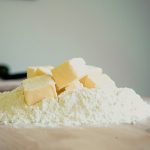Enzymes play a pivotal role in the baking industry, significantly enhancing the quality, consistency, and efficiency of baked products. These biological catalysts are proteins themselves that accelerate chemical reactions, enabling bakers to achieve desired characteristics in their products. Not only does incorporating enzymes into baked goods improve their taste and texture, they can also increase shelf-life, improve the volume of the food, create new textures and even reduce harmful chemicals that make their way into the baked good (Santos et al., 2020).
Enzymes are naturally present in flour and other baking ingredients, but they can also be added in controlled amounts to achieve specific effects. This post will explore the various enzymes used in baking, their functions, benefits, and applications.
Types of Enzymes Used in Baking
- Amylases: Amylases are among the most widely used enzymes in baking. They catalyze the hydrolysis of starch into sugars, which serve as a food source for yeast during fermentation. There are two main types of amylases:
- α-Amylase: This enzyme breaks down large, insoluble starch molecules into smaller dextrins and oligosaccharides, which can be further hydrolyzed by other enzymes. α-Amylase helps in achieving a better crumb structure and increased loaf volume by promoting gas production during fermentation.
- β-Amylase: This enzyme works on the non-reducing ends of starch molecules, releasing maltose units. It is particularly important for developing flavor and crust color in bread.
- Proteases: Proteases break down proteins into smaller peptides and amino acids. In baking, proteases are used to modify gluten, the protein network in wheat flour. By partially hydrolyzing gluten, proteases can improve dough handling properties, reduce mixing times, and enhance the extensibility of the dough. This is especially useful in products like crackers and cookies, where a tender texture is desired.
- Lipases: Lipases catalyze the hydrolysis of fats into fatty acids and glycerol. They are used in baking to modify lipid structures, which can improve dough stability, texture, and flavor. Lipases can also help in the emulsification of fats, leading to a more uniform crumb structure and longer shelf life.
- Xylanases: Xylanases break down hemicellulose, a major component of the cell wall in cereals, into xylose and other simple sugars. This enzymatic action improves dough elasticity and gas retention, leading to increased loaf volume and a finer crumb structure. Xylanases are particularly useful in whole grain and high-fiber breads.
- Glucose Oxidase: This enzyme catalyzes the oxidation of glucose to gluconic acid and hydrogen peroxide. In baking, glucose oxidase strengthens the dough by cross-linking gluten proteins, improving dough stability and gas retention. It also reduces the need for chemical oxidizing agents, making the baking process cleaner and more natural.
- Transglutaminase: Transglutaminase catalyzes the formation of covalent bonds between glutamine and lysine residues in proteins. In baking, it is used to strengthen the gluten network, improving dough elasticity and bread volume. It is particularly useful in gluten-free baking, where it can help mimic the structure and texture of gluten-containing products.
- Lipoxygenase: Lipoxygenase is an enzyme that oxidizes fatty acids, leading to the bleaching of flour pigments and the strengthening of gluten. This enzyme is often used in bread making to produce whiter crumb color and improved dough handling characteristics.
Benefits of Enzymes in Baking
- Improved Dough Handling: Enzymes like proteases and xylanases modify the dough’s rheological properties, making it easier to knead, shape, and mold. This is especially beneficial in automated baking processes, where consistent dough behavior is crucial.
- Enhanced Bread Volume and Crumb Structure: Amylases, proteases, and other enzymes contribute to better gas retention and distribution in the dough. This results in increased loaf volume, a more open crumb structure, and a finer texture.
- Flavor and Aroma Development: Enzymes such as β-amylase and lipase play a significant role in the development of flavor and aroma in baked goods. By breaking down starches and fats, these enzymes release sugars and fatty acids that contribute to the Maillard reaction and other browning processes, enhancing the sensory qualities of the final product.
- Extended Shelf Life: Enzymes like lipases and glucose oxidase can improve the shelf life of baked products. By modifying the lipid content and strengthening the dough structure, these enzymes reduce staling and help maintain product freshness for longer periods.
- Cost Reduction: The use of enzymes can reduce the need for chemical additives and processing aids, leading to cost savings. For example, glucose oxidase can replace chemical oxidizing agents, while amylases can reduce the need for added sugars.
- Health and Nutrition: Enzymes can be used to create healthier baked products by reducing sugar and fat content. For instance, amylases can enhance natural sweetness by breaking down starches into sugars, reducing the need for added sugars. Similarly, lipases can help in reducing the fat content by breaking down existing fats into more digestible components.
Applications of Enzymes in Baking
- Bread Making: Enzymes are extensively used in bread making to improve dough handling, loaf volume, crumb texture, and shelf life. For example, the combination of amylases and xylanases can significantly enhance the quality of whole wheat and multigrain breads.
- Cookies and Crackers: Proteases are commonly used in cookie and cracker production to control dough toughness and improve the final texture. The enzyme-modified gluten network results in a tender bite and reduces shrinkage during baking.
- Pastries and Cakes: Enzymes like lipases and proteases are used in pastries and cakes to improve batter stability, crumb softness, and volume. They also help in achieving a finer texture and better moisture retention.
- Gluten-Free Products: In gluten-free baking, enzymes like transglutaminase are invaluable for mimicking the functional properties of gluten. They help in developing a cohesive dough structure, which is otherwise challenging to achieve with gluten-free flours.
- Frozen Dough: Enzymes are beneficial in frozen dough applications, where they help maintain dough strength and elasticity after thawing. This is particularly important for maintaining product quality in the frozen food industry.
Enzymes are indispensable tools in modern baking, offering a wide range of benefits from improved product quality to cost savings. Their ability to modify dough properties, enhance flavor, and extend shelf life makes them essential ingredients in both traditional and innovative baking processes. As the demand for healthier and more natural baked products grows, the use of enzymes is likely to expand, offering bakers new opportunities to innovate and meet consumer needs.
References
, , , , & (2020). Effect of added psyllium and food enzymes on quality attributes and shelf life of chickpea-based gluten-free bread. Lebensmittel-Wissenschaft & Technologie, 134, 110025 (Article).



Leave a Reply